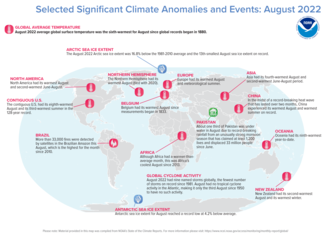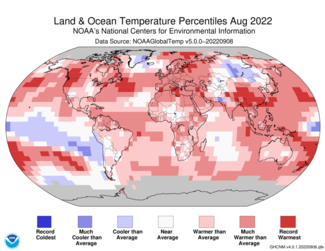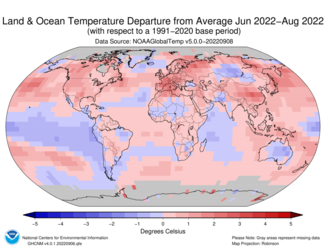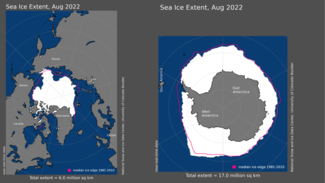Earth had its sixth-warmest August on record

Globally, August 2022 was the sixth-warmest August in the 143-year NOAA record. The year-to-date (January-August) global surface temperature was the sixth-warmest on record. According to NCEI’s Global Annual Temperature Outlook, there is a greater than 99% chance that 2022 will rank among the 10-warmest years on record but less than 11% chance that it will rank among the top five.
This monthly summary, developed by scientists at NOAA’s National Centers for Environmental Information, is part of the suite of climate services NOAA provides to government, business, academia and the public to support informed decision-making.
Monthly Global Temperature
The August global surface temperature was 1.62°F (0.90°C) above the 20th-century average of 60.1°F (15.6°C). This was the sixth-warmest August in the 143-year record. August 2022 marked the 46th consecutive August and the 452nd consecutive month with temperatures, at least nominally, above the 20th-century average. The Northern Hemisphere August temperature tied with 2020 as the warmest for August on record at 2.16°F (1.20°C) above average.
North America and Europe each had their warmest August on record. Asia had its fourth-warmest August on record. South America, Africa and the Oceania region had August temperatures that were above average, but not among their top 10 warmest on record.
Temperatures were above average throughout most of North America, Europe, and southern and southeastern Asia, and across parts of northern Africa, northern South America, the Arabian Peninsula, western Asia and northern Oceania. Parts of the northwestern U.S., southwestern Canada, Spain, Italy, China, southeast Asia and New Zealand experienced record-warm temperatures for August. Sea surface temperatures were above average across much of the Gulf of Mexico and the northern, western and southwestern Pacific, as well as parts of the northern and southern Atlantic oceans.
Temperatures were near- to cooler-than-average throughout most of South America and across parts of central Asia. Consistent with La Niña, sea surface temperatures were below average over much of the south-central, central, and eastern tropical Pacific. None of the world's surface had a record-cold temperature in August.
Seasonal Global Temperature
The June-August 2022 global land and ocean surface temperature was 1.60°F (0.89°C) above the 20th-century average of 60.1°F (15.6°C) and tied with 2015 and 2017 as the fifth-warmest June-August period in the 143-year record. The five warmest June-August periods on record have occurred since 2015.
The June-August period is defined as the Northern Hemisphere’s meteorological summer and the Southern Hemisphere’s meteorological winter. The Northern Hemisphere summer 2022 temperature was the second-warmest summer on record at 2.07°F (1.15°C) above average. Summer of 2020 was warmer by only 0.05°F (0.03°C). Meanwhile, the Southern Hemisphere had its 10th-warmest winter on record.
Regionally, Europe had its warmest meteorological summer in the 113-year continental record. Asia and North America each had their second-warmest June-August on record, while Africa had its 11th-warmest June-August (tied with 2002) on record. South America and Oceania had above-average June-August periods, but they did not rank among their top 10 on record.
Sea Ice
Globally, August 2022 saw the fifth-lowest August sea ice extent on record.
Arctic sea ice extent in August averaged 2.31 million square miles, which is about 467,000 square miles below the 1981-2010 average. This marks the 13th-smallest August extent in the 44-year record. Sea ice extent was well below average in the Barents, Chukchi, Laptev, Kara, and Greenland seas, and the Hudson Bay. Sea ice extent for August was not above average anywhere in the Arctic this month.
For the third consecutive month, Antarctica set a record low sea ice extent since records began in 1979. The August 2022 Antarctic sea ice extent was 6.55 million square miles, or about 290,000 square miles below average.
Global Tropical Cyclones
Nine named storms occurred across the globe in August. Four of those reached tropical cyclone strength (74 mph), including Super Typhoon Hinnamnor, the first Category 5 tropical cyclone of 2022. August 2022 had no named tropical cyclone in the Atlantic, which is only the third August since 1950 to have no such activity. The Augusts of 1961 and 1997 were the only others to also finish with no activity in the Atlantic. This August marks only the seventh year since 1950 to have no hurricanes in the Atlantic Ocean through August 31.
For a more complete summary of climate conditions and events, see our August 2022 Global Climate Report.







